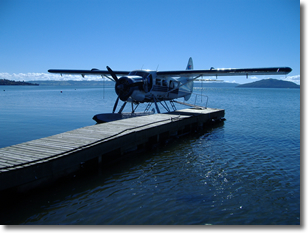
Otters in New Zealand
Click on an image for a larger picture
Having been asked by some members to give an account of my recent exploits in New Zealand, I will begin with my fantastic “flight-seeing” trip over the volcanic lakes at Rotorua.
To many people, the spectacular scenery would be the object of the exercise but of course to this club member, the purpose was a trip in the De Haviland Otter float plane. De Haviland built over 450 of these aircraft for military use but this particular model was built in 1954 and is currently the only one in New Zealand, being bought in 2004. The cost of purchasing and restoring this particular aircraft amounted to approx. NZ$ 1.0m. It is operated by Volcanic Air Services and is appropriately registered as ZK- VAS.
It is powered by a nine cylinder, Pratt and Whitney 600 h.p. radial engine. This combination has a 38% reduction gear on the prop. The nett weight of the aircraft is 5,275lbs with a payload of approx. 2,700lbs. It has seating for nine passengers and I was the lucky one in the front seat. This precise type can cope with seas as high as 8 ft. but lakes of this size, even in this part of the world, rarely experience such conditions. The weather on this particular day was perfect and the still water presented its own problems. Landing on still or “glass water” as it is called can cause problems with visual perceptions.
Volcanic Air Services also operate a couple of Cessna 206’s on floats as well as three helicopters. The pilot today was Phil Baclay, M.D. of the company. He has over 4,000 hrs. on floatplanes since 1979 and was very accommodating and patient with the “child” that he had as a front seat passenger on this particular flight.
After start-up, with oil and cylinder head temps. in the green, manifold pressure at ambient setting of 29.75 ins. and rpm in excess of 2,000, the power checks were completed.
The taxi was somewhat different to what we club fliers normally experience. No yellow lines to follow but many small craft to negotiate on our way out to the area past the markers on the lake. Normally the engine develops 600 h.p at 36.5 ins. manifold pressure but due to the lighter load to-day, Phil selected 31.5 ins. to conserve the engine. He explained that this would yield ample power at approx. 470h.p. Heavy waves or winds can sometimes restrict the take-off but conditions today being ideal, the 46 sq. mile lake offered ample room.
The take off “roll” was again very different to what we normally experience. A small amount of spray splashed up from the floats at first. The roar of the big radial was music to the ears and was barely reduced by the David Clarkes. The nose is initially kept high to avoid the prop. coming into contact with the water. As the speed over the water builds up, things soon change however, as Phil lowered the nose to raise her up on the steps, at approx. 20mph water speed. This was done by “feel” as it was much too slow for the A.S.I. and the aircraft quickly accelerated to rotating speed as she rose in the water. Holding her straight and steady to avoid porpoising, he gently but promptly lifted her clear at approx. 48 to 50 mph.
With the elevation of Rotorua Lake being 930ft ASL, the initial climb for this sturdy old girl at 85mph, gives a climb rate of 100 to 300 fpm, depending on the air temperature. Easing back to 27.5” and 1900 rpm at about 3,000 ft. gave approx. 105 mph. Fuel consumption at these settings is in the order of 135lts or 30gph. All this time the mooring ropes trail harmlessly back in the slipstream from the underside of the wings. Phil invited me to take control for a brief while to get a feel for this fabulous bird. I was amazed how docile she was and how light and positive she was to the controls.
Throughout the climb and cruise, Phil gave a very detailed commentary on the amazing landscape ahead and below. New Zealand is noted for its spectacular scenery. On previous occasions during our holiday on the South Island, we enjoyed the spectacular coastline of the southern Pacific on the west coast, the dramatic snow-capped Southern Alps, and the glaciers on the east coast. Today however it was very different day in Rotorua. This is in the middle of the North Island and is the centre of the Mouri culture. It was almost reminiscent of an underworld scene. The mineral enriched blue and green volcanic lakes, geysers, and volcanic hills in the Te Whakarwarewa Thermal Valley and Puketawhero Park seemed to be straight out of a J.R. Tolkien book. Little wonder that the Lord of the Rings movies were filmed in this part of the world.
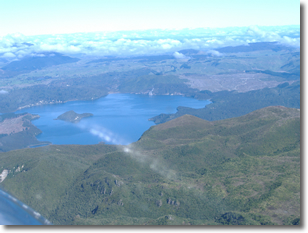 |
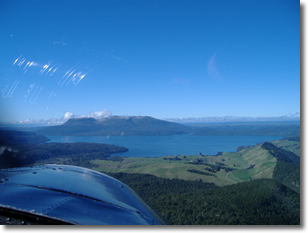 |
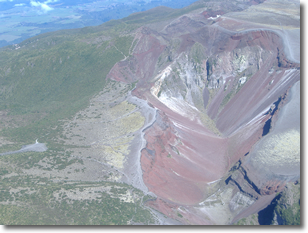 |
Normal descent is at 300 to 400 fpm at 115 mph. Phil however, began the descent to-day at a rate of 100 fpm to avoid shock cooling the cylinders and supercharger. Turning into wind, the initial approach at 65mph is made at 18” and 1,500rpm, while finals of 55 to 60 mph, depending on load and wind, resulted in an undramatic splash down (Sorry, touch down.) as the power is slowly eased off.
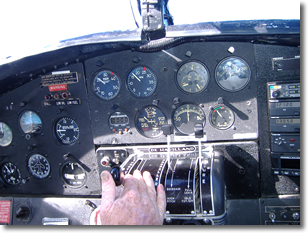 |
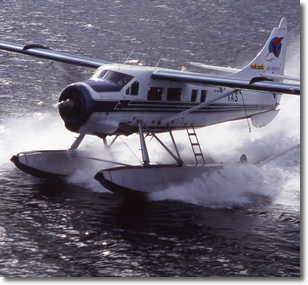 |
We carefully negotiated our way slowly back to the dock. The mooring was an experience in itself. Having shut down, Phil nimbly vacated his pilot’s seat as the aircraft drifted close in and with the deftness of a much younger man, he easily made his way between the floats to secure the mooring ropes. Having done so he then made the craft secure before positioning the ladder and gang plank for the passengers. He later explained that this operation is normally done with the aid of a dock hand but on this occasion, I suspect that the dock hand had gone for a beer.
Following the flight, Phil kindly gave me the low down on the aircraft and patiently answered all my questions. It was a wonderful experience and I was most grateful to him for his contribution. His manner was typical of the response which I experienced from other Kiwi pilots that I had the pleasure to meet on the trip.
Truly, the possession of a PPL is a privilege to value and to be enjoyed all around the world. The delights are willingly shared by all I have had the pleasure to meet.
Visit www.volcanicair.co.nz, for further information on this company.
The history of this particular aircraft is as follows,
Mar 1954 Delivered to the RCAF and saw service in Nova Scotia.
May 1957 Used by the U.N. in Egypt, flying to Gaza and Jerusalem.
Jan 1967 Returned to Canada and saw service in Goose Bay and Labrador.
Oct 1975 Retired and put in storage.
April 1977 Transferred to Ministry of Nat. Resources, Ontario.
Jan. 1986. Sold to U.S. company and operated in Alaska.
May 2000. Sold again, this time in Maine in U.S.A..
June 2002. Back to Labrador to Air Caribou.
July 2004. Dismantled and freighted to Volcanic Air Safaris, Rotorua, N.Z.
The above information from DHC-3 Otter- A History. Compiled and produced by Karl E. Hayes, available on CD at £14.00
Jim Ryan. August 2006.